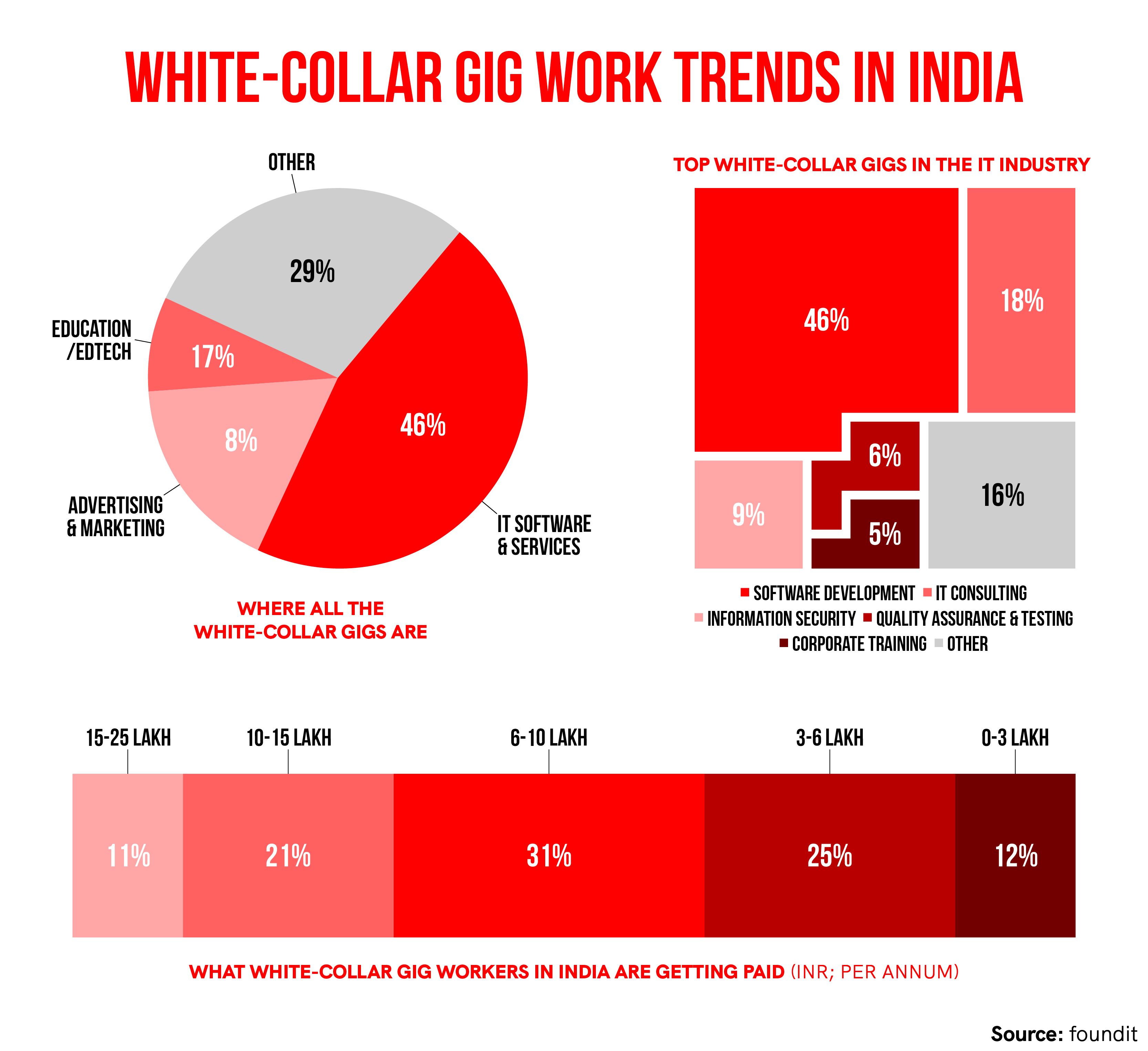
- Highly skilled professionals in India are choosing gig work for flexibility, work-life balance, and higher salaries, particularly in the IT sector.
- Demand for gig workers, especially in areas like full-stack development, data science, and cloud engineering, is increasing.
- Gig work provides tax advantages and increased net earnings for consultants/freelancers.
- The gig economy offers cost savings and flexibility for companies, allowing them to scale their workforce based on project needs.
- Challenges in the gig economy include data security, intellectual property theft, and cultural alignment.
” data-brand=”yourstory” contenteditable=”false” data-clicktext=”” data-clickurl=”” data-pageurl=”https://yourstory.com/2023/07/flexibility-better-salaries-high-skilled-professionals-gig-work-it-demand” data-sectiontype=”Key Takeaways” data-emailid=”ishan.p@yourstory.com”>
font-size: 1rem;
padding-bottom: 1.1rem;
color: #171B1C;
width: auto !important;
padding: 1.5rem 0.875rem;
margin: 1rem 0rem !important;
background: #FFFEF5;
box-shadow: 0px 4px 24px rgba(130, 150, 165, 0.25);
height: 100%;
display: block;
position: relative;
.keyTakeAWaysContainer li, .keyTakeAWaysContainer p
font-family: Adobe Caslon Pro !important;
font-style: normal;
font-weight: 400 !important;
font-size: 21px !important;
line-height: 29px !important;
color: #0F171C !important;
.ql-editor .keyTakeAWaysTitlePara
font-family: Adobe Caslon Pro !important;
font-style: normal;
font-weight: 700 !important;
font-size: 20px !important;
color: #FFFFFF !important;
margin: 0 !important;
text-align: center;
line-height: 20px !important;
.keyTakeAWaysTitlePara
font-family: Adobe Caslon Pro !important;
font-style: normal;
font-weight: 700 !important;
font-size: 22px !important;
color: #FFFFFF !important;
margin: 0 !important;
text-align: center;
line-height: 20px !important;
margin-top: 5px !important;
.keyTakeAWaysWrapper
position: relative;
margin: 6% 0px;
.ql-editor .keyTakeAWays
margin: 1rem !important;
.keyTakeAWays
margin: 3rem 1rem !important;
.keyTakeAWays ol li:before
counter-increment: headings;
content: counter(headings) ”;
.ql-editor .keyTakeAWays ol li
padding-top: 2rem;
list-style-position:outside;
list-style-type: none;
.ql-editor .keyTakeAWays ul li
padding-top: 2rem;
list-style-position:outside;
list-style-type: disc;
.keyTakeAWays ol li
padding-top: 2rem;
list-style-position:outside;
list-style-type: none;
.keyTakeAWays ul li
padding-top: 2rem;
list-style-position:outside;
list-style-type: disc;
.keyTakeAWays ol li
padding-top: 2rem;
list-style-position:outside;
list-style-type: none;
display: table;
.keyTakeAWays ul li
padding-top: 2rem;
list-style-position:outside;
list-style-type: disc;
.keyTakeAWays ol li:not(.ql-direction-rtl), .keyTakeAWays ul li:not(.ql-direction-rtl)
padding-left: 0 !important;
.ql-editor .keyTakeAWays li::before,
.ql-editor .keyTakeAWays li::marker
width: 12px;
height: 24px;
font-family: Adobe Caslon Pro !important;
font-style: normal;
font-weight: 400;
font-size: 21px;
line-height: 24px;
color: #0F171C;
padding-right: 0em;
.keyTakeAWays li::before,
.keyTakeAWays li::marker
width: 12px;
height: 24px;
font-family: Adobe Caslon Pro !important;
font-style: normal;
font-weight: 400;
font-size: 21px;
line-height: 24px;
color: #0F171C;
padding-right: 0em;
.keyTakeAWays li::marker
unicode-bidi: unset !important;
font-variant-numeric: unset !important;
text-transform: none;
text-indent: 0px !important;
text-align: unset !important;
text-align-last: unset !important;
.keyTakeAWays ul > li::before
display: inline-block;
white-space: nowrap;
width: unset;
.ql-editor .keyTakeAWays .inline_link
color: #0F171C !important;
border: 1px solid #0F171C;
padding: 2px 5px 0px !important;
text-decoration: none !important;
margin: 0px 3px 5px !important;
.keyTakeAWays .inline_link,
.keyTakeAWaysContainer > ol > li > .link,
.keyTakeAWaysContainer > ul > li > .link
color: #0F171C !important;
border: 1px solid #0F171C;
padding: 5px 5px 0px 5px !important;
text-decoration: none !important;
text-align: center !important;
display: inline-block !important;
margin: 0px 3px 5px !important;
.ql-editor .keyTakeAWays .inline_link,
.ql-editor .keyTakeAWaysContainer > ol > li > .link,
.ql-editor .keyTakeAWaysContainer > ul > li > .link
color: #0F171C !important;
border: 1px solid #0F171C;
padding: 5px 5px 0px 5px !important;
text-decoration: none !important;
text-align: end !important;
display: inline-block !important;
margin: 0px 3px 5px !important;
.keyTakeAWays u
border-bottom: 1px solid #0F171C;
text-decoration: none !important;
padding-bottom: 0px !important;
display: inline-block !important;
width: auto !important;
.keyTakeAWays .keyTakeAWaysPointsWrapper
margin: unset !important;
.keyTakeAWaysContainer p:is(:first-child)
margin: 4% 1% 3% 5.5%;
.keyTakeAWaysContainer p:not(:first-child)
margin: 4% 1% 3% 5.5%;
.keyTakeAWaysContainer p:last-child:has(br:only-child)
margin: 0 !important;
.keyTakeAWaysContainer p:is(:first-child) .keyTakeAWaysTitleWrapper
top: -1rem;
.keyTakeAWays .company-widget
font-size: 20px !important;
color: #000000 !important;
cursor: pointer !important;
font-weight: 600 !important;
font-family: Adobe Caslon Pro !important;
display: unset !important;
.ql-editor .keyTakeAWays .company-widget::after,
.keyTakeAWays .company-widget::after
font-family: pt-sans !important;
content: ‘i’;
font-size: 12px !important;
border-radius: 20px !important;
border: 2.6px solid #000000 !important;
color: #000000 !important;
transform: translateY(-24%) !important;
line-height: 14px !important;
display: inline-block !important;
height: 17px !important;
width: 17px !important;
margin: 0px 0.2rem !important;
text-align: center !important;
font-weight: 900;
padding-top: 2px;
.ql-editor .keyTakeAWaysTitleWrapper
height: 37px;
width: 181px;
display: flex;
align-items: center;
background: black;
justify-content: center;
position: absolute;
top: -1rem;
left: 6%;
.keyTakeAWaysTitleWrapper
height: 37px;
width: 210px;
display: flex;
align-items: center;
background: black;
justify-content: center;
position: absolute;
top: -1rem;
left: 6%;
.ql-editor .keyTakeAWays ul
counter-reset: headings;
.keyTakeAWays ul
counter-reset: headings;
.ql-editor .keyTakeAWays ol
counter-reset: headings;
.keyTakeAWays ol
counter-reset: headings;
.keyTakeAWays ol
margin: 0 !important;
padding: 0 !important;
.ql-editor .keyTakeAWays ul, .ql-editor .keyTakeAWays ol
margin: 0px 0px 0px 0.8rem !important;
padding: 0 !important;
border-collapse: separate;
border-spacing: 1.5rem;
.keyTakeAWays ul
margin: 0px 0px 0px 0.8rem !important;
padding: 0 !important;
border-collapse: separate;
border-spacing: 1rem 2rem;
.keyTakeAWays ol
margin: 0px 0px 0px 0.5rem !important;
padding: 0 !important;
border-collapse: separate;
border-spacing: 1rem 2rem;
.ql-editor .keyTakeAWays ol, .ql-editor .keyTakeAWays ol
padding: 0 !important;
border-collapse: separate;
border-spacing: 1.5rem;
.keyTakeAWays ol
display: table !important;
.keyTakeAWays ul
display: table !important;
.keyTakeAWays ol li
list-style: none !important;
display: table-row !important;
.keyTakeAWays ul li
list-style: none !important;
display: table-row !important;
text-indent: unset !important;
.keyTakeAWays ol li::before
display: table-cell !important;
text-align: right !important;
.keyTakeAWays ul li::before
display: table-cell !important;
text-align: right !important;
padding-right: 0rem !important;
content: “\2022” !important;
.ql-editor .keyTakeAWays ul li:not(.ql-direction-rtl)::before
margin: 0px !important;
@media (max-width: 769px)
.keyTakeAWaysContainer p:is(:first-child)
margin: 13% 1% 3% 5.5% !important;
.keyTakeAWaysContainer p:not(:first-child)
margin: 4% 1% 3% 5.5% !important;
.keyTakeAWays ul, .keyTakeAWays ol
margin: 0px !important;
.keyTakeAWays .inline_link,
.keyTakeAWaysContainer > ol > li > .link,
.keyTakeAWaysContainer > ul > li > .link
text-align: center !important;
.keyTakeAWaysTitleWrapper
width: 155px;
height: 30px;
top: -1rem;
left: 12.5%;
.ql-editor .keyTakeAWaysTitlePara
font-family: Adobe Caslon Pro !important;
font-style: normal;
font-weight: 400 !important;
font-size: 16px !important;
.keyTakeAWaysTitlePara
font-family: Adobe Caslon Pro !important;
font-style: normal;
font-weight: 400 !important;
font-size: 16px !important;
margin-top: 5px !important;
.keyTakeAWaysContainer
margin: 1% 0px 0rem 0px !important;
.keyTakeAWaysContainer li, .keyTakeAWaysContainer p
font-family: Adobe Caslon Pro !important;
font-style: normal;
font-weight: 400 !important;
font-size: 17px !important;
line-height: 24px !important;
.keyTakeAWays li::before,
.keyTakeAWays li::marker
width: 5px;
height: 24px;
font-family: Adobe Caslon Pro !important;
font-weight: 500;
font-size: 14px !important;
line-height: 24px;
color: #0F171C;
padding-right: 0em;
.keyTakeAWays ul > li::before
width: unset !important;
font-size: 18px !important;
.keyTakeAWaysPointsWrapper
box-shadow: 0px 4px 24px rgba(170, 167, 162, 0.38);
padding: 0.8rem 0.5rem 1rem !important;
.ql-editor .keyTakeAWays ol > li
padding-top: 1rem;
list-style-type: none;
list-style-position: inside;
.keyTakeAWays ol > li
padding-top: 1rem;
list-style-type: none;
list-style-position: outside;
.ql-editor .keyTakeAWays ul > li
padding-top: 1rem;
list-style-type: disc;
list-style-position: inside;
text-indent: -6% !important;
margin-left: 1em !important;
.keyTakeAWays ul > li
padding-top: 1rem;
list-style-type: disc;
list-style-position: inside;
.keyTakeAWays
margin: 2rem 1rem 3.5rem !important;
.keyTakeAWaysContainer p
margin: 4% 4% 0 8% !important;
.keyTakeAWaysContainer p:last-child:has(br:only-child)
margin: 0 !important;
.ql-editor .keyTakeAWays .company-widget::after,
.keyTakeAWays .company-widget::after
height: 0.8rem !important;
width: 0.7rem !important;
.ql-editor .keyTakeAWays .company-widget,
.keyTakeAWays .company-widget
font-size: 1.12rem !important;
line-height: 0.9rem !important;
.keyTakeAWays li::before, .keyTakeAWays li::marker
padding: 0px !important;
@media (max-width: 300px)
.keyTakeAWaysTitleWrapper
left: 18% !important;
top: -1rem !important;
.keyTakeAWaysContainer p:is(:first-child)
margin: 14% 1% 3% 4.5% !important;
.keyTakeAWaysContainer p:not(:first-child)
margin: 4% 1% 3% 4.5% !important;
@media (min-width: 200px) and (max-width: 389px)
.keyTakeAWays ul > li::before
width: unset !important;
.keyTakeAWays ul > li
padding-top: 1rem;
list-style-type: disc;
list-style-position: inside;
@media (min-width: 500px) and (max-width: 600px)
.keyTakeAWaysTitleWrapper
left: 8% !important;
.keyTakeAWaysContainer p:is(:first-child)
margin: 8% 1% 3% 2.5% !important;
.keyTakeAWaysContainer p:not(:first-child)
margin: 4% 1% 3% 2.5% !important;
@media (min-width: 390px) and (max-width: 500px)
.keyTakeAWays ul li:not(.ql-direction-rtl)::before
margin-left: -1em !important;
margin-right: 0em !important;
.keyTakeAWaysContainer p:is(:first-child)
margin: 12.5% 1% 3% 5.5% !important;
.keyTakeAWaysContainer p:not(:first-child)
margin: 4% 1% 3% 5.5% !important;
@media (min-width: 768px) and (max-width: 820px)
.keyTakeAWays ul li:not(.ql-direction-rtl)::before
margin-left: -0.3em !important;
margin-right: 0em !important;
@media (max-width: 1280px)
.keyTakeAWaysTitlePara
margin-top: 5px !important;
@media (min-width: 768px) and (max-width: 768px)
.keyTakeAWaysTitleWrapper
left: 6% !important;
top: -1rem !important;
.keyTakeAWaysTitlePara
margin-top: 3px !important;
.keyTakeAWaysContainer p:is(:first-child)
margin: 8% 1% 3% 2.5% !important;
.keyTakeAWaysContainer p:not(:first-child)
margin: 4% 1% 3% 2.5% !important;
@media (min-width: 414px) and (max-width: 417px)
.keyTakeAWays ol
border-spacing: 1.6rem 2rem !important;
.keyTakeAWays ul
border-spacing: 1.2rem 2rem !important;
}
Key Takeaways
- Highly skilled professionals in India are choosing gig work for flexibility, work-life balance, and higher salaries, particularly in the IT sector.
- Demand for gig workers, especially in areas like full-stack development, data science, and cloud engineering, is increasing.
- Gig work provides tax advantages and increased net earnings for consultants/freelancers.
- The gig economy offers cost savings and flexibility for companies, allowing them to scale their workforce based on project needs.
- Challenges in the gig economy include data security, intellectual property theft, and cultural alignment.
“I have the freedom to work from my hometown or any location of my choice without the need to commute to an office,” Ravindra S, a Java developer working for a leading IT company, tells YourStory.
Like Ravindra, a seasoned professional with almost a decade of experience as a Full Stack Developer with prominent IT firms, other highly-skilled individuals YourStory spoke to are opting for gig work over traditional full-time employment.
The top reasons for this shift are: flexibility, improved work-life balance, and higher in-hand salaries.
Currently working with a team of nearly 25 professionals, Ravindra says gig work reduces constraints on his time. “I can log in and out at my convenience. Even at 10 PM, I can simply provide an update on my current tasks. And the absence of countless meetings throughout the day is a refreshing change,” he adds.
A gig economy represents a free market concept where employers engage independent workers for short-term assignments. The advantage of the model includes reduced fixed costs and labour as well as talent market constraints.
“The demand for gig workers in the IT – software and services industry has gone up by 24% in the last three months. Full stack is the most sought skill in demand followed by Python and Java for gig workers,” remarks Sekhar Garisa, CEO, (formerly Monster), a job search platform.
According to Awign’s data, there was a 240% surge in demand for high-skill talent in the last calendar year. The work-as-a-service platform notes that the demand for highly-skilled professionals for specialised gigs is on the rise. This trend is particularly prominent in the tech industry, with roles like full-stack developers, data scientists, React and Java developers, and cloud engineers seeing increased demand.
In particular, companies are looking for gig workers for backend positions like Python, Java, PHP, Go, Ruby, Kotlin, C#, .Net, and frontend positions such as React, Vue.js, and Angular, along with roles in data engineering, microservices, system integration, AI/ML engineering, and mobile application development.
With a master’s degree in Computer Science and nearly 15 years of experience in the IT sector, full stack developers Swati V and Divya K, also say that gig work gives them a better work-life balance.

Increased cash flow
Ravindra, who formerly worked as a Java developer, now enjoys the advantages of being a consultant, and has tax advantages, resulting in increased take-home earnings. He secured his current project through Awign and is now on the payroll of the work-as-a-service platform.
When companies engage ready-to-go professionals for short-term positions, they are often willing to offer higher salaries due to the immediate access they gain to specialised talent.
Moreover, there is an increased demand for specialised expertise in short-term projects, further driving up the need for talented professionals. Consequently, companies acknowledge the value of these professionals’ skills and are more inclined to provide competitive salaries to attract them.
This dynamic leads to higher net salaries for experts in the gig economy since companies recognise that they are paying for immediate access to specialised knowledge and skills without the long-term commitments and overhead costs associated with full-time employment.
Additionally, gig workers or freelancers in India can benefit from tax advantages under the Presumptive Taxation scheme outlined in Section 44DA of the Income Tax Act.
If a freelancer’s annual income is below Rs 50 lakh, only 50% of their gross income, equivalent to Rs 25 lakh, is considered taxable. As a result, tax deductions are lower, allowing freelancers to receive higher net pay compared to full-time employees who are liable to pay taxes on their entire income of Rs 50 lakh.
says that it does not impose any charges on gig workers or experts for the projects they undertake. Instead, it charges enterprise clients (companies) based on the specific requirements of each project.
In platforms operating on a work-as-service model, clients are typically subject to a service fee for the work performed by the platform on behalf of the company. This fee can be calculated as a percentage of the project’s value, a fixed rate, or a combination of both, depending on the particular platform’s policies.
Among the various tech-enabled gig platforms, fulfilment platforms distinguish themselves by offering end-to-end solutions, encompassing the entire lifecycle of gig work for enterprises. Apart from Awign, India has , , TaskMo, and .
<figure class="image embed" contenteditable="false" data-id="520330" data-url="https://images.yourstory.com/cs/2/d99b1110116911ed9e63f54395117598/WhiteCollarGigWorkersInfographics-1688823436328.jpg" data-alt="White-collar gig work" data-caption="
Infographic design credit: Nihar Apte
” align=”center”> Infographic design credit: Nihar Apte
.thumbnailWrapper
width:6.62rem !important;
.alsoReadTitleImage
min-width: 81px !important;
min-height: 81px !important;
.alsoReadMainTitleText
font-size: 14px !important;
line-height: 20px !important;
.alsoReadHeadText
font-size: 24px !important;
line-height: 20px !important;

Demand and supply
According to foundit’s Garisa, the gig economy is continuously evolving and has seen 93% growth since January 2023 in the white-collar space.
“Gig workers are in huge demand as they provide companies with flexibility in scaling their workforce up or down based on project needs or fluctuating workloads along with cost savings,” Garisa explains.
Gig work reduces fixed costs in the profit and loss statement (P&L), notes Gurpreet Singh, Co-founder and Chief Business Officer of Awign. Offloading these costs enhances the flexibility and efficiency of the P&L model, he adds.
Moreover, the recognition of remote work’s effectiveness has drawn talented individuals to this model, Singh says, adding that presently, 70% of Awign experts are involved in IT-related tasks. These experts are highly educated professionals with specialised knowledge and strong domain expertise who are engaged in white-collar jobs.
Sumit Sabharwal, CEO of HRtech says that the gig economy has expanded to senior levels, with project leaders and technology leaders now willing to work on short-term contracts, ranging from three to six months, depending on the project.
“This growing trend, particularly in India, allows for the engagement of experienced professionals on project-specific terms, resulting in potentially higher salaries. It is not uncommon to find individuals with 14-15 years of experience joining projects on a contractual basis,” he adds.
Although these professionals have the option to be absorbed on a full-time basis by the companies they collaborate with after completing a project, many of them opt to persist in pursuing gig work opportunities, according to Awign.
In the gig ecosystem, Awign says it offers stability by curating multiple opportunities from diverse clients, ensuring that talented individuals have a consistent flow of projects at their disposal.
“As long as projects like this exist, I plan to continue working in this manner,” Ravindra says. This sentiment resonates with others, such as Swati and Divya, who also believe that the current setup enables them to enhance their skills and pursue their passions and interests.

Gigfying white-collar work
According to a joint study by and , before the pandemic, approximately 50% of gig workers were primarily found in the retail, trade and transportation sectors. However, now nearly 35% of gig workers are employed in the IT sector.
It is anticipated that soon, every third employee within an IT organisation will be a gig worker, the findings from the study released in March show.
The shift in the workforce is significant, given that it comes amid the current dichotomy of mass layoffs and skilled worker shortage. As organisations explore new business models to circumvent this dichotomy, they will increasingly onboard gig workers, according to the study.
Although engaging gig workers offers numerous advantages, there are also challenges to consider. These include concerns related to data security, intellectual property theft, access management, and cultural alignment. The Microsoft and Zinnov study highlights that these challenges impact various phases in the life cycle of gig workers, such as planning, onboarding, execution, and payment.
The study notes that addressing the challenging and essential phases of onboarding and execution is crucial, with over 70% of CXOs recognising that doing so can facilitate the widespread adoption of the gig economy model.
However, there are some challenges as well for gig workers. When asked about potential job security issues and uncertainties in employment, Ravindra admits that these concerns have crossed his mind, especially since he previously had full-time employment. However, at present, he has no intention of returning to a full-time job despite the uncertainties. While it is premature to predict the future, he remains committed to his current path as a consultant.
As IT firms explore the utilisation of gig platforms to effectively engage with workers and fulfil gig work requirements, this trend is also gaining momentum in other sectors.
TeamLease HRtech’s Sabharwal says this trend is apparent in the HR and finance fields. “These practices are expected to continue expanding as we progress into 2024,” he remarks.
The gig workforce, consisting of 7.7 million workers across industries, will be pivotal in propelling India’s $5 trillion economy forward. With projections indicating that this talent pool is expected to expand to 23.5 million workers by 2030, these gig workers are estimated to generate $250 billion worth of work, notes the joint study by Microsoft and Zinnov.
(Cover image and infographic by Nihar Apte.)
Edited by Affirunisa Kankudti










